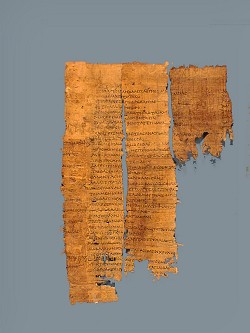
Met uitzondering van Egypte, waar men veel gebruik maakte van (voordelige) potscherven, was papyrus in de antieke culturen rond de Middellandse Zee het meest gebruikte schrijfmateriaal. Andere materialen, zoals perkament en tafeltjes van was of hout, waren verhoudingsgewijs van minder belang, en pas in de 8e eeuw na Christus werd papyrus geleidelijk vervangen door papier, gemaakt van lompen.
De papyrologie heeft als object van studie de Griekse en Latijnse papyri en ostraca; teksten in Egyptisch schrift worden aan de specialisten binnen de Egyptologie overgelaten. De belangrijkste taak van de papyrologie is het zorgvuldig ontcijferen van de tekst van een papyrus en het maken van een transcriptie, waarbij men vaak te maken heeft met ontbrekende delen die door vergelijking met andere teksten soms kunnen worden aangevuld. Op basis van deze reconstructie wordt vervolgens een vertaling gemaakt, waarbij in een commentaar alle bijzonderheden worden aangegeven. Het publiceren van het bronnenmateriaal, dat daardoor beschikbaar komt voor verdere bestudering, is het hoofddoel van de papyrologie.
Met betrekking tot de geschiedenis van het Oude Egypte is de papyrologie van belang, omdat zij veel informatie kan aanleveren over het leven in Egypte gedurende de Ptolemeïsche Periode en de Romeinse periode. Zo kunnen we bijvoorbeeld een idee krijgen van de dagelijkse levensomstandigheden in de dorpen, maar ook van grotere economische ontwikkelingen gedurende die perioden, of van de ontwikkeling van het recht. Voor de geschiedenis van de Egyptische religie zijn de papyri interessant als bron van informatie voor de studie van de volksvroomheid in de vorm van liederen, gebeden en magische spreuken of voor de studie van het vroege christendom. Verder bieden de papyri informatie over de ontwikkeling van de Griekse taal en het schrift.
De papyrologie als wetenschappelijke discipline bestaat inmiddels ruim honderd jaar. Dankzij haar is er niet alleen een enorme hoeveelheid informatie beschikbaar gekomen, maar is het raadplegen van directe bronnen in plaats van de bekende antieke auteurs vanzelfsprekend geworden.